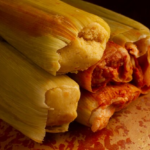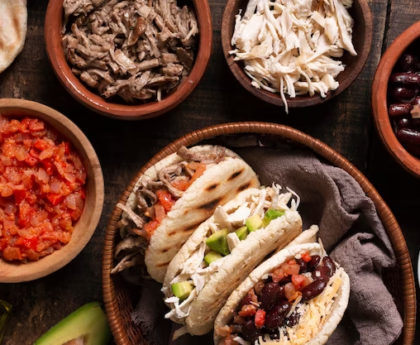San Antonio, Texas, is known for its rich history, diverse culture, and of course, its mouth-watering Mexican food. Whether you’re craving traditional dishes passed down through generations or a modern twist on classics, San Antonio’s culinary landscape has got you covered. This article highlights some of the best Mexican restaurants in San Antonio, TX.
San Pedro’s Culinary Chronicles: An Ode to Traditional Mexican Flavors!
San Pedro in San Antonio isn’t merely a locale; it’s a sensory journey through the rich and vibrant tapestry of Mexican cuisine. Each establishment here is a chapter, each dish a tale, and each flavor an emotion. Some iconic venues that demand attention include:
- Los Barrios: This is not just a spot on San Pedro; it’s the heart of it. For generations, this family fortress of flavors has been narrating stories of tradition, culture, and culinary prowess. Their menu is a curated selection of time-honored family recipes, blending age-old techniques with modern flair. Their signature “puffy tacos” and seafood delicacies are dishes every culinary explorer must experience at least once;
- El Mirasol: A testament to the evolution of Mexican cuisine, El Mirasol seamlessly marries tradition with innovation. The restaurant, with its picturesque patio, provides diners an ambiance that is as compelling as the dishes themselves. Their modern take on classic favorites and their unparalleled margaritas are emblematic of San Antonio’s culinary renaissance.
Market Square: A Culinary Tapestry Weaving History and Flavor
Market Square is not just a place; it’s an experience. Every corner of this vibrant mosaic resonates with the melodies of mariachis, the laughter of locals, and the aromas of authentic Mexican dishes. Standout venues include:
- Mi Tierra Café y Panadería: Serving as the culinary anchor of Market Square, Mi Tierra’s legacy spans over eighty years. It is a kaleidoscope of colors, sounds, and tastes. Whether it’s the bustling ambiance, the resonating notes of live mariachi, or the extensive menu that takes one on a voyage through Mexico’s diverse regions, every moment here is a celebration;
- La Margarita: When culinary connoisseurs speak of Mexican gastronomy in San Antonio, the conversation inevitably turns to La Margarita. Its artful ensemble of dishes, headlined by the sizzling fajitas, and the carefully crafted margaritas have made it a pilgrimage site for food lovers.
Celebrating San Antonio’s Culinary Luminaries: Beyond the Ordinary
Delving deeper into San Antonio’s gastronomic galaxy, some stars shine brighter, serving as beacons for those craving the quintessential Mexican dining experience:
- Rosario’s: Rosario’s stands tall as a testament to the fusion of Texan hospitality and Mexican culinary traditions. Amidst the bustling heartbeats of San Antonio, it offers a sanctuary for food lovers. The tableside guacamole is an experience, an invitation to participate in the culinary process, and the expansive menu guarantees a delightful dilemma of choices;
- Tito’s Mexican Restaurant: Tito’s is not just about food; it’s about passion poured onto plates. Their dedication to preserving and presenting the essence of Mexican cuisine is evident in every dish, from the richly layered enchiladas to the diverse tamales that capture the spirit of Mexico.
The Alamo City’s Hidden Culinary Tales
San Antonio’s food scene is vast, and some stories remain whispered secrets, shared only by those in the know. Here are two more venues that deserve their place in the limelight:
- Casa Azul de Andrea: Nestled away from the city’s bustling epicenter, Casa Azul offers a tranquil dining experience, characterized by its azure-themed interiors and meticulously crafted dishes. From their handmade tortillas to the melt-in-your-mouth churros, every bite here is a homage to Mexico’s rich culinary heritage;
- Mariposa’s Latin Kitchen: A contemporary haven for Latin flavors, Mariposa’s dances on the crossroads of modern techniques and traditional recipes. Their tapas-style offerings allow diners to sample a wide array of dishes, and their signature cocktails add the perfect finishing touch to an exceptional dining experience.
Traditional Mexican Influence

- Proximity to Mexico: To understand San Antonio’s culinary heritage, one must consider its geographical location. The city’s proximity to Mexico, sharing a border with its southern neighbor, has played a pivotal role in shaping its culinary journey. This proximity has ensured a steady flow of authentic Mexican flavors, recipes, and cooking techniques;
- Authentic Mexican Flavors: At the heart of San Antonio’s culinary heritage is its dedication to preserving the authenticity of Mexican flavors. Fundamental ingredients such as corn, chiles, beans, and an array of aromatic spices are the cornerstones of this influence. These ingredients are used in various forms, reflecting the diversity of Mexican regional cuisines;
- Incorporation of Mexican Dishes: San Antonio’s culinary landscape is graced with a wide array of beloved Mexican dishes, each with its unique regional twist. Tamales, enchiladas, tacos, and chiles rellenos have been lovingly adopted and adapted, becoming integral components of the local food culture. These dishes, prepared with care and reverence, transport diners to the heart of Mexico itself;
- Salsas and Moles: Central to Mexican cuisine are salsas and moles, complex sauces that elevate dishes to culinary masterpieces. San Antonio’s chefs have embraced this tradition, creating a spectrum of salsas ranging from fiery and smoky to tangy and herbaceous. The famous mole, a rich and velvety sauce made with chocolate, chiles, and spices, is a testament to the city’s commitment to preserving Mexican culinary traditions.
Tex-Mex Evolution
- Birth of Tex-Mex: As the decades rolled on, San Antonio’s culinary scene underwent a fascinating evolution. Traditional Mexican dishes began to merge with Texan tastes, giving birth to Tex-Mex cuisine. This fusion is celebrated for its unique blend of flavors and has become synonymous with San Antonio’s identity;
- Key Tex-Mex Elements: Tex-Mex cuisine in San Antonio incorporates elements that were less prevalent in traditional Mexican cooking. Cheese, beef, and wheat flour tortillas became staples, leading to iconic dishes like chili con carne, nachos, and fajitas. The use of cheese and chili transformed Mexican recipes into hearty and indulgent Tex-Mex creations;
- Tex-Mex Restaurants: San Antonio boasts a myriad of Tex-Mex restaurants, some of which have been serving their signature dishes for generations. These establishments offer a seamless fusion of traditional Mexican and Texan flavors, creating a truly distinctive culinary experience. From the renowned Mi Tierra Café to the iconic Ray’s Drive Inn, these establishments continue to be beloved landmarks in the city;
- The Breakfast Taco: An iconic Tex-Mex creation that deserves special mention is the breakfast taco. This humble yet delicious dish consists of a warm tortilla filled with scrambled eggs, crispy bacon or chorizo, and a variety of toppings such as cheese, salsa, and avocado. It’s a staple of San Antonio mornings and a testament to the city’s love for Tex-Mex comfort food.
Diverse Culinary Techniques

- Roasting and Grilling: San Antonio’s Mexican cuisine is characterized by a spectrum of cooking techniques that enhance the flavors of meats and vegetables. Roasting and grilling, often over open flames or on charcoal grills, play a significant role. The smoky and charred essence imparted by these methods adds depth and complexity to dishes like carne asada and grilled nopales (cactus paddles);
- Slow-Cooking Traditions: The art of slow-cooking is deeply embedded in San Antonio’s culinary heritage. Dishes like barbacoa and menudo require hours of simmering to develop their rich and complex flavors. Slow-cooked meats, prepared with care and patience, are tender and succulent, reflecting the dedication put into their preparation;
- Use of Comal: In San Antonio’s kitchens, the comal, a flat griddle, is an indispensable tool. It is used to cook tortillas, roast chiles, and prepare other essential components of Mexican and Tex-Mex dishes. The comal’s versatility makes it a symbol of tradition, connecting generations through the act of cooking;
- The Importance of Masa: Masa, the dough made from corn that serves as the basis for tortillas and tamales, is the backbone of San Antonio’s culinary heritage. The meticulous process of nixtamalization, where dried corn is soaked in an alkaline solution, is crucial in preparing masa. This process not only enhances flavor but also makes essential nutrients more accessible;
- Chiles and Spices: San Antonio’s cuisine is known for its bold and vibrant flavors, thanks in large part to the use of chiles and spices. Ancho, guajillo, and pasilla chiles are often used to add depth and heat to dishes. Cumin, oregano, and cilantro are some of the key spices that infuse a burst of flavor into salsas, stews, and marinades.
Key Highlights of San Pedro’s Mexican Restaurants

San Pedro Avenue in San Antonio, Texas, is a hub for Mexican cuisine enthusiasts, offering a wide array of traditional and modern Mexican dishes. Here are some key highlights of San Pedro’s Mexican restaurants:
- Traditional and Modern Mexican Dishes: San Pedro’s Mexican restaurants pride themselves on serving both traditional and modern Mexican dishes. You can savor classics like enchiladas, tacos, and tamales, while also enjoying innovative creations that fuse Mexican flavors with contemporary culinary techniques;
- Family-Friendly Settings: Many of the Mexican food restaurants in San Antonio, Texas, located on San Pedro Avenue, provide a family-friendly atmosphere. It’s an ideal place to dine with your loved ones, offering comfortable seating and a welcoming ambiance;
- Diverse Menu Options: Whether you’re a fan of spicy mole or prefer the simplicity of puffy tacos, San Pedro’s Mexican restaurants cater to diverse tastes. From sizzling fajitas to rich and flavorful pozole, you’ll find an extensive menu with something for everyone.
When exploring San Antonio, make sure to visit Market Square, a vibrant cultural and culinary destination. Here are some notable dishes from Market Square eateries:
- Mi Tierra’s Carne Guisada: Mi Tierra is renowned for its hearty Carne Guisada, a savory stew of tender beef simmered in a rich and flavorful gravy. It’s a must-try dish that embodies the essence of Tex-Mex cuisine;
- La Margarita’s Mole Poblano: Mole Poblano is a complex and aromatic sauce made with chocolate and chili peppers. La Margarita serves a delectable version of this dish that perfectly balances sweetness and spice, making it a favorite among locals and visitors alike;
- Classic San Antonio Style Puffy Tacos: When in San Antonio, don’t miss out on the classic puffy tacos. These crispy yet soft tortillas are filled with your choice of meat, lettuce, tomatoes, and cheese, creating a satisfying and iconic Tex-Mex experience.
Conclusion
San Antonio is a haven for Mexican cuisine lovers. From the bustling streets of San Pedro to the vibrant vibes of Market Square, the city is packed with eateries that serve some of the best Mexican food in San Antonio, Texas. Whether you’re a resident or a visitor, make sure to indulge in the flavors of these outstanding restaurants.
FAQs
San Antonio’s Mexican cuisine is deeply rooted in history and influenced by various regions of Mexico. The blend of traditional recipes with Tex-Mex elements makes it stand out.
Absolutely! Many Mexican food restaurants in San Antonio, Texas, offer a variety of vegetarian and vegan dishes. It’s always a good idea to check the menu or inquire beforehand.
Market Square is undoubtedly a hub for some of the best Mexican restaurants in San Antonio, TX. However, places like San Pedro and other parts of the city also boast outstanding eateries.
While some establishments might accept walk-ins, it’s generally recommended to make reservations, especially during peak hours and weekends.




